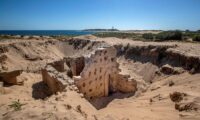 The remains of a Roman bath from the 4th century have emerged from the dunes of Cape Trafalgar near Cádiz, on the southwest coast of Spain. Roman buildings in any condition are rare survivals in Cádiz because the ancient city, founded by Phoenicians 3,100 years ago, was destroyed during the Visigothic conquest of southern Spain in 410 A.D., and this building is unusually well-preserved by the winds that quickly buried it in sand after it was abandoned.
The remains of a Roman bath from the 4th century have emerged from the dunes of Cape Trafalgar near Cádiz, on the southwest coast of Spain. Roman buildings in any condition are rare survivals in Cádiz because the ancient city, founded by Phoenicians 3,100 years ago, was destroyed during the Visigothic conquest of southern Spain in 410 A.D., and this building is unusually well-preserved by the winds that quickly buried it in sand after it was abandoned.
The surviving walls are 13 feet high (the remains of Roman structures are typically foundations and short walls no more than two feet high) and contain numerous windows and doors. There are fragments of the red, white and black stucco used to decorate the walls, as well as marble cladding.
“It is a structure that has an exceptional state of conservation for the Iberian Peninsula and the western Mediterranean in general,” Darío Bernal, a professor of archaeology at the University of Cádiz, tells Efe. […]
Bernal and his team believe the building was a sophisticated rural bath complex complete with an oven-fueled hot air current that warmed the walls and floors.
It most likely served as a communal hot bath for local workers, many of whom would have toiled away in odorous coastal jobs like fish farming and salting.
 Indeed, the archaeology team was exploring the site as part of a research project investigating the history of Roman aquaculture in the area. When the structure first emerge, Bernal thought it was a cetaria, a fish pond connected to the sea where fish and crustaceans were fattened up. Wealthy Romans attached these nurseries to their estates so they had a constant supply of the best fish for their own consumption and to sell.
Indeed, the archaeology team was exploring the site as part of a research project investigating the history of Roman aquaculture in the area. When the structure first emerge, Bernal thought it was a cetaria, a fish pond connected to the sea where fish and crustaceans were fattened up. Wealthy Romans attached these nurseries to their estates so they had a constant supply of the best fish for their own consumption and to sell.
Fishing and fish products were the main industry in this area during the Roman era. What is now Cádiz was a major producer of garum, the sauce made of crushed and fermented fish intestines that was consumed in prodigious quantities by people from every walk of life all over the Roman empire. The garum from the Hispania Baetica province was considered the best, and the remains of garum factories have been found in Cádiz and other towns along the coast.
Local authorities are now considering what to do with the dune baths once excavations are complete. One possibility is to maintain it as an archaeological park to attract tourism. The other is just to let the wind do its thing and bury it back in the sand for its own protection.
I use the history blog as my browser homepage. Every day I begin the day reading about something that is interesting and informative – and well written, too.
I always learn something new that it is free from the day-to-day strife and chaos available in the news media. Today it was news to me – the business of fishing and fish products from long ago.
Every day, it’s one more informative topic which I can appreciate. It’s the best way to start the day.
Does anybody know, what those “neaches” might be, and what would make this a public bath?
cf.: en.wikipedia.org/wiki/Thermae#Building_layout
:hattip:
———
PS: Myself, I once visited the ruins of this one here (unfortunately, with hardly any walls at all):
upload.wikimedia.org/wikipedia/commons/b/b6/Cyark_Weissenburg_Reconstruction.jpg
en.wikipedia.org/wiki/Biriciana
de.wikipedia.org/wiki/Römische_Thermen_(Weißenburg)
BP Murphy, instead of “Garum”, ordinary Fish Souce from your local Asia Shop might work as well. –cf. gutenberg.org/ebooks/search/?query=apicius (also, there basically should be plenty of youtube videos).
From the PREFACE: “Obscure Terminology”
————
GARUM is another word, one upon which much contemptuous witticism and [22] serious energy has been spent. Garum simply is a generic name for fish essences. True, garus is a certain and a distinct kind of Mediterranean fish, originally used in the manufacture of garum; but this product, in the course of time, has been altered, modified, adulterated,—in short, has been changed and the term has naturally been applied to all varieties and variations of fish essences, without distinction, and it has thus become a collective term, covering all varieties of fish sauces. Indeed, the corruption and degeneration of this term, garum, had so advanced at the time of Vinidarius in the fifth century as to lose even its association with any kind of fish. Terms like garatum (prepared with g.) have been derived from it. Prepared with the addition of wine it becomes œnogarum,—wine sauce—and dishes prepared with such wine sauce receive the adjective of œnogaratum, and so forth.
The original garum was no doubt akin to our modern anchovy sauce, at least the best quality of the ancient sauce. The principles of manufacture surely are alike. Garum, like our anchovy sauce, is the purée of a small fish, named garus, as yet unidentified. The fish, intestines and all, was spiced, pounded, fermented, salted, strained and bottled for future use. The finest garum was made of the livers of the fish only, exposed to the sun, fermented, somehow preserved. It was an expensive article in old Rome, famed for its medicinal properties. Its mode of manufacture has given rise to much criticism and scorn on the part of medieval and modern commentators and interpreters who could not comprehend the “perverse taste” of the ancients in placing any value on the “essence from putrified intestines of fish.”
However, garum has been vindicated, confirmed, endorsed, reiterated, rediscovered, if you please, by modern science! What, pray, is the difference in principle between garum (the exact nature of which is unknown) and the oil of the liver of cod (or less expensive fish) exposed to the beneficial rays of ultraviolet light—artificial sunlight—to imbue the oil with an extra large and uniform dose of vitamin D? The ancients, it appears, knew “vitamin D” to exist. Maybe they had a different name for “vitamins,” maybe none at all. The name does not matter. The thing which they knew, does. They knew the nutritive value of liver, proven by many formulæ. Pollio, one of the vicious characters of antiquity, fed murenas (sea-eel) with slaves he threw into the piscina, the fish pond, and later enjoyed the liver of the fish.
Some “modern” preparations are astonishingly ancient, and vice versa. Our anchovy sauce is used freely to season fish, to mix with butter, to be made into solid anchovy or fish paste. There are sardine pastes, lobster pastes, fish forcemeats found in the larder of every good kitchen—preparations of Apician character. A real platter of hors d’oeuvres, an antipasto is not complete unless made according to certain Apician precepts.
————
e.g.: [Dish number 497] THRUSH “À LA SANTÉ” (“TURDOS HAPANTAMYNOS” [1]) – en.wikipedia.org/wiki/American_robin (you could try quails, instead):
CRUSH PEPPER, LASER, LAUREL BERRY, MIX IN CUMIN [2] GARUM AND STUFF THE THRUSH [with this preparation, [3]] THROUGH THE THROAT [4], TYING THEM WITH A STRING. THEREUPON MAKE THIS PREPARATION IN WHICH THEY ARE COOKED [i.e. fried]: CONSISTING OF OIL, SALT, WATER [5], DILL AND HEADS OF LEEKS.
Annotations:
———–
[1] Cf. Summary of Dishes; term not identified, derived from the Greek, meaning to drive away all stomach ills.
[2] We use juniper berries today instead of cumin. [“instead” of???]
[3] Cf. note to ℞ 496, XXVIII.
[4] Thrush and other game birds of such small size are not emptied in the usual way: they are cooked with the entrails, or, the intestines are taken out, seasoned, sauté, and are either put back into the carcasses, or are served separately on bread croutons. In this instance, the necessary seasoning is introduced through the throat, a most ingenious idea that can only occur to Apicius.
[5] In other instances we have pointed out where a small amount of water was used to clarify the oil used for frying foods. The presence here of water leads us to believe that the thrush were not “cooked,” i.e. “boiled” but that they were fried in a generous amount of oil; this would make the ancient process remarkably similar to the present European way of preparing thrush or fieldfare, or similar game birds. For water used to clarify oil see note 3 to ℞ No. 250.
:hattip: Bon appetit!
Well, Apicius, I must repair my laser, although the instructions could be clearer – do I aim the laser at the individual particles of pepper or can I blast them all at once with some kind of diffuser?
Trevor, maybe you and your villa need to buy a fine and freshly imported COOK for this 😉
Indeed –as in most other medieval (and very early medieval) collections– the given hints are tight. It certainly becomes much clearer in Latin (“Lasar”).
Note that I found No. 497 as “Turdos Aponcomenus” in Liber XI, XXIX:
Ăpŏnus , i, m., = ἄπονος (pain-curing).
comedo = glutton
λάσαρον, lāsar, lasaris (n) = the juice of the plant laserpitium, asafoetida (botany) the plant laserpitium itself
Lasaris radix = The root of the laserpitium.
—-
TVRDOS APONCOMENOS: “Teres piper, lasar, bacam lauri, admisces cuminum, garum et sic turdum per guttur imples et filo ligabis. et facies ei impensam, in quo decoquantur, quae habeat oleum, sales, aquam, anethum et capita porrorum.”
—-
penelope.uchicago.edu/Thayer/E/Roman/Texts/Apicius/Vinidarius*.html#XXIX
Feel free to also have a look at –with more practical hints (in German) that you could easily translate w/ deepl.com
imperiumromanum.com/kultur/kulinarium/kulinarium_rezepte_index.htm
Veni, vidi, comedit.
I have seen garum compared to the Vietnamese sauce nam noc – apparently also an acquired taste, but used extensively in the home area.